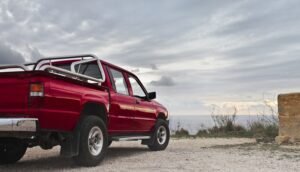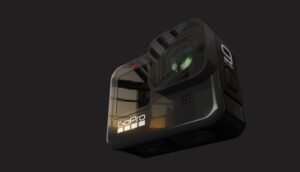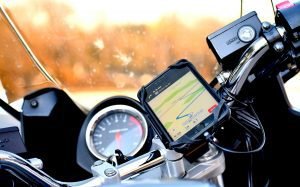Best and Cheap Motorcycle Helmet Cameras
Updated on | By Mohit Chauhan
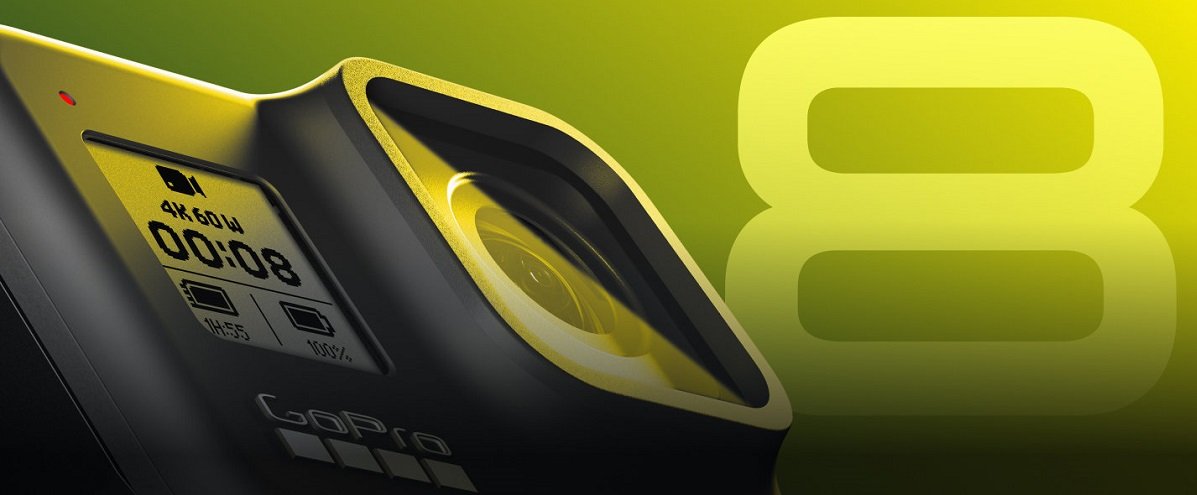
Reader Disclosure
Our editorial content is reader-supported. If you click on some of our links, we may earn a small commission. Learn more here.Can you imagine going on an adventurous motorcycle trip without a camera that would capture the moments, sceneries, and the memories of your journey for you to glance back when you are feeling low? Sadly, it used to happen with our classic motorcyclists a decade ago, when all they had was a piece of paper with some notes written about their journey.
Luckily, today, motorcycle helmet cameras are capable of capturing beautiful photos and high definition videos that you can share with your friends and family once you have completed your journey or even while you are at it.
But any ordinary camera can shoot and record, so why bother to buy an action camera for a helmet?
Trying to capture something interesting and beautiful, we, in fact, isolate ourselves from reality; we see not the events themselves, but their faded pixel copy on the mobile or a camera screen. An action camera is the only way to shoot and see at the same time. When you pick up an action camera, you feel an interesting psychological effect, which can be called the syndrome “I think I’m 16 years old again”. All unfulfilled ideas and thoughts, hopelessly left in the past, suddenly become desirable, real, and feasible again. You will want to rediscover the world of outdoor activities, return to sports, get a motorcycle, perform a stunt and, of course, head out for an expedition. Action camera makes you feel younger. Besides, possessing an “extreme” device, you yourself become a little bit extreme and change your way of life.
When shooting with an action camera, the angle is usually the same as the first person view. The camera is rigidly fixed, which is why every movement relative to the environment is felt in the picture. Dynamics is the middle name of action cameras, so while watching such videos; the effect of complete re-immersion in the experience is created.
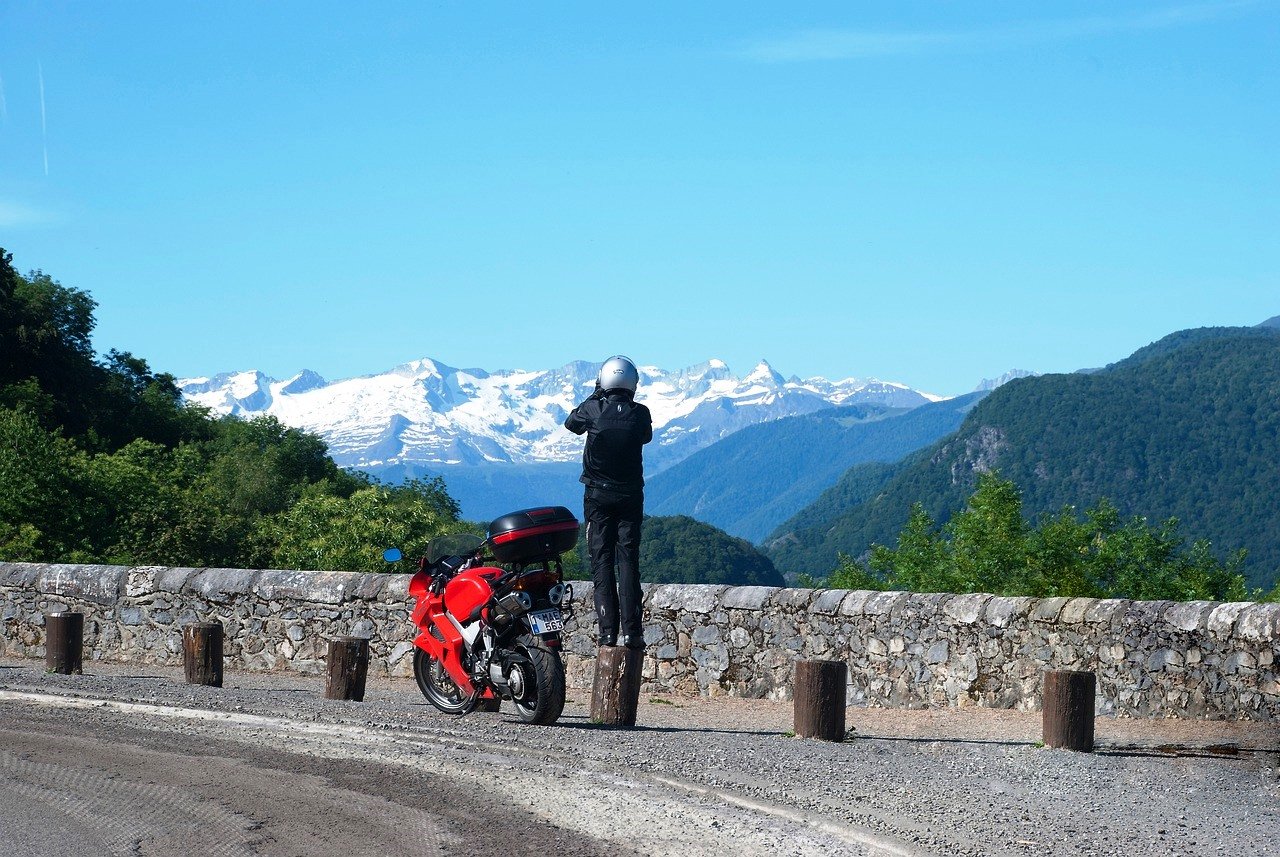
Comparison of Motorcycle Helmet Cameras
| Model | GoPro Hero 8 Black | Campark Xtreme | Apeman A87 | Akaso Brave 7 | Akaso EK7000 Pro | DJI Action 2 | Insta 360 GO 2 |
|---|---|---|---|---|---|---|---|
| Price | $299 | $109 | $109 | $169 | $84 | $279 | $254 |
| Splashproof | Yes | Yes | Yes | Yes | Yes | Yes | Yes |
| Waterproof Depth | 10m | 40m | 40m | 10m | 40m | 60m | 4m |
| Touch Screen | Yes | Yes | Yes | Yes | Yes | Yes | No |
| Bike Mount | No | Yes | Yes | Yes | Yes | No | Yes |
| External Memory | Yes | Yes | Yes | Yes | Yes | Yes | No |
| Wi-Fi | Yes | Yes | Yes | Yes | Yes | No | Yes |
| GPS | Yes | No | No | No | No | No | No |
| Voice Command | Yes | No | No | Yes | No | No | No |
| Battery | 1220mAh | 1350mAh | 1050mAh | 1350mAh | 1050mAh | 580mAh | 1100mAh |
| Slow Motion Video | Yes | Yes | No | Yes | No | Yes | Yes |
| MegaPixels | 12MP | 20MP | 20MP | 20MP | 20MP | 12MP | 9MP |
| View Angle | 150 Degree | 170 Degree | 170 Degree | 170 Degree | 170 Degree | 155 Degree | 120 Degree |
| Recording | 2160 x 60fps | 4K x 60fps | 4K x 60fps | 4K x 30fps | 4K x 30fps | 4K x 60fps | 2560 x 50fps |
| Microphones | 3 | 1 | 1 | 1 | 1 | 1 | 1 |
Best Budget Motorcycle Helmet Cameras
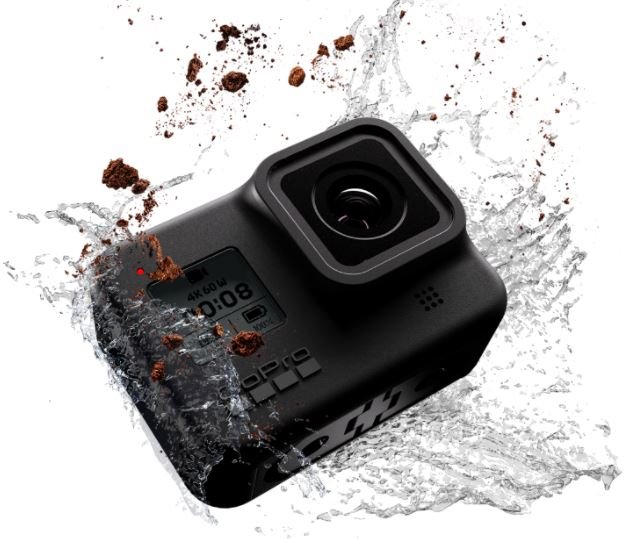
GoPro Hero 8 Black
While the GoPro 8 is no longer the brands flagship camera, for those of you who do not have the need for 5K or a front-facing screen, this smaller, lighter GoPro from 2019 would be just about right.
In fact, the GoPro Hero 8 Black is easy to use, has plenty of features and boasts state-of-the-art image stabilization technology known to be the best amongst all action cameras. You can also upgrade the Hero8 Black even further with a new line of beautifully designed optional extras called mods. For instance, you can add the Display Mod, which adds a front facing screen in case you prefer motovlogging.
The camera has great capabilities in slow motion mode; you can shoot 4K resolution at 60 frames per second, and 1080p at 240 frames per second. Other enhancements include improved background sound, advanced night mode, as well as wider dynamic range. In addition, HDR image capture has been improved and the quality of the shoot is simply amazing!
In fact, finding a helmet camera superior to the GoPro Hero 8 Black is no easy task (in this price range). With it, you are able to capture interesting content for several hours without needing to change the battery, thanks to its 2 hours long battery backup.
Buying this gadget is not just about putting a cute little camera on your helmet, but an opportunity to join the big army of GoPro fans. You will get unlimited access to invaluable tips, tricks, and all kinds of support.
Most importantly, there’s a livestream option on board, so you can share your adventures with the rest of the world right on Facebook. In fact, GoPro has even tweaked the app making it now even easier to edit and share your clips.
We were previously impressed with the GoPro Hero 7 Black, but the creators of the new Hero 8 Black managed to improve the already excellent action camera. The camera is now equipped with the new HyperSmooth 2.0 video stabilizer and 1080p of live streaming, which has increased its capturing quality from its predecessor.
All in all, Hero 8 is one of the most economical action cameras from GoPro and yet offers all the advanced features and functionalities in order to capture all your adventurous moments.
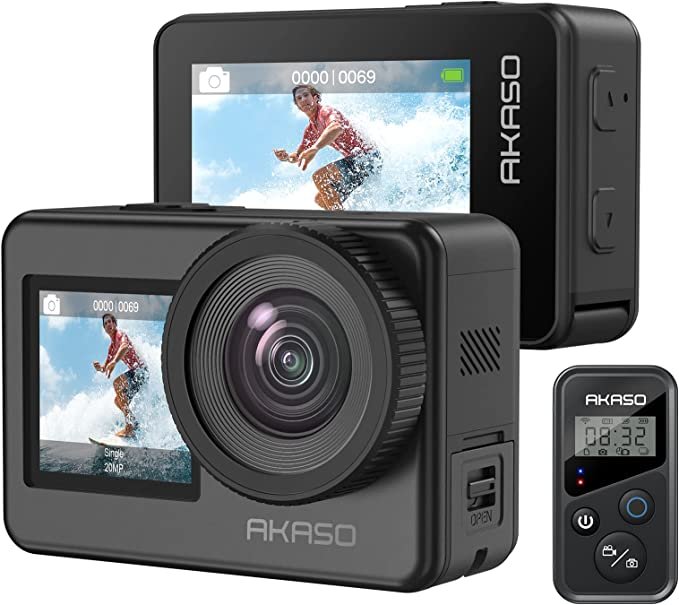
Akaso Brave 7
We all know the problem with GoPro’s: If you purchase a new action cam, you not only have to dig deep into your pockets, but you also have to buy almost all of the accessories separately. Things are quite different with Akaso: The Brave 7 costs just about half compared to the GoPro 8 and comes with almost everything you need to attach with your motorcycle helmet.
So, by introducing Brave 7, Akaso fulfilled its promise to deliver a full-fledged action camera that costs just around $170.
Featuring a 20-megapixel CMOS sensor, the Akaso Brave 7 LE provides good quality photos and videos as tested by our team of riders. There is a maximum video resolution of 4K, which by the way has become customary in new era action cams, a 6-axis digital image stabilizer, and a two-inch touch-display at the back followed by a mini 1.4 centimeter display up front to let riders capture exactly what they need to.
You can choose between 4K@30fps, 2.7K@30fps, 1080p@60fps and 1080p@30fps. If you want to record Slo-Mo videos, you can choose 720p with 120 full frames, or you can choose between 720p@60fps and 720p@30fps.
Besides a slow-motion mode, the specifications also include a time-lapse mode. Plus, in riding mode, the camera turns on automatically as soon as it is connected to the USB charger and the bike is started (See: How to install a USB on motorcycle).
Moreover, the video length can be set to 3, 5 and 7 minutes. In addition, you can also adjust the exposure, sharpness, balance and select from various preset settings and filters.
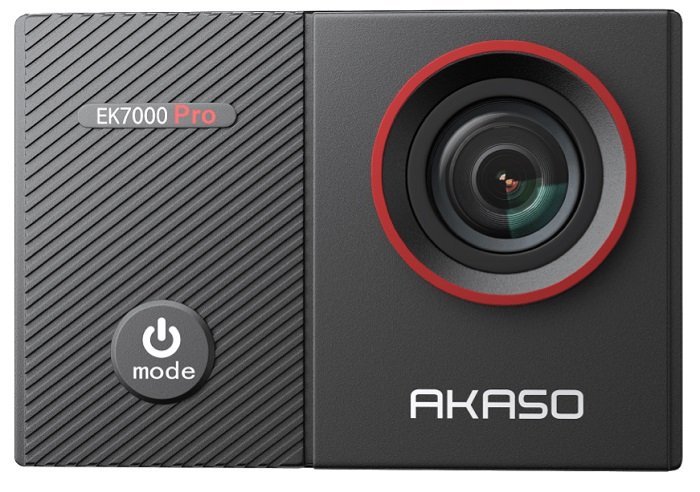
Akaso EK7000 Pro
GoPro’s industry-leading cameras are known for their image quality and ease of use, but even the cheapest production camera costs well over $299. That’s where the Akaso EK7000 Pro comes in, being one of many inexpensive alternatives of the GoPro that costs well below $100. And while its price is really impressive, so are its features.
With a 2-inch touchscreen display, the AKASO EK7000 Pro action cam features an IPS panel with liquid crystals arranged in an overlapping pattern, providing a precise reproduction of each individual pixel. This results in less color distortions, wider viewing angles and higher brightness.
The camera records moving images in Ultra HD or 4K at 25fps and 2.7K at 30fps. Photos are captured at a resolution of 16 megapixels, which might be lower than that of other action cams, but are perfectly ideal for personal use. And thanks to the camera’s waterproof housing, the EK7000 Pro is resistant to water up to a depth of 40 meters.
And in addition to the several mounts and waterproof housing, the EK7000 Pro has a wrist-mounted remote control that can be used to control the camera on the go. This remote comes with built-in Wi-Fi, which is fairly easy to enable in the settings and pairs quite effortlessly. Once activated, the two-button remote can be used to start and stop recording as well as capture still images.
As a handy bonus, the camera automatically switches between still photo and video mode when the alternate button is pressed.
The second battery and the included dual charger are also something well thought about by the brand. This allows you to charge both the batteries at the same time without wasting any of your time. What more can you ask from such an inexpensive action cam?
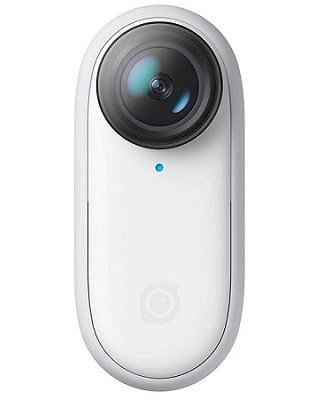
Insta 360 GO 2
In 2019, Insta360 introduced the first version of their Go action camera in a compact format, with surprisingly good recording quality and great stabilization. However, the recording time was limited to a maximum of three minutes, making its application limited to certain situations.
The successor Go 2 basically features a similar design, but with a redesigned charging case and 150 minutes of recording time.
As for the camera size, it is just about 53 mm in height, 23.6 mm in width, and 20.6 mm in thickness, including the lens cover. With a weight of 26.5 g, it measures about the same as your motorcycle keys. As such, the Go 2 is a few mm larger and about 8.5 g heavier than its predecessor, but it is still tiny compared to a conventional action cam.
But that’s not all: The case also features dual buttons and a small screen allowing the Insta360 Go 2 to be operated while it is in the case. In the case, the action cam performs just like a full-fledged camera offering several features and sufficient battery life. Moreover, the action cam can also be mounted on a tripod or a selfie stick.
As an alternative, the Go 2 can be detached from the case and can be controlled via smartphone using the Insta360 app.
Another great convenience of the Insta360 Go 2 is that it is magnetic. This means that it can be quickly and easily attached to numerous metallic objects, as well as can easily be hooked up to the accessories included in the package.
The image sharpness is absolutely stunning and even the Full HD recordings (1920×1080 pixels) look rich in detail. And while the Go 2 does not support 4K resolution (3840×2160 pixels), this can sometimes be seen as an advantage since the internal memory lasts for a very long time.
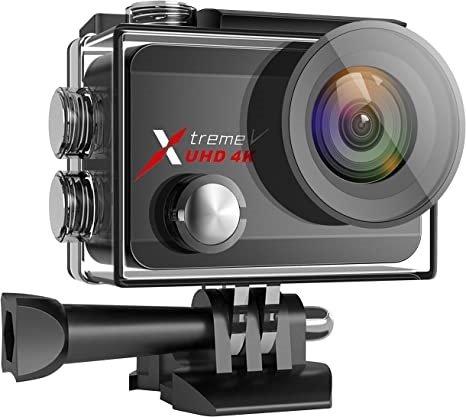
Campark Xtreme
Not everyone wants to spend hundreds of dollars on a motorcycle helmet camera just because they can afford it. To add to this, we often are skeptical about these devices, especially when using them for the first time.
Buying quality helmet cameras without spending good money is quite difficult. But thanks to Campark Xtreme, you can own an action camera, that is cheap, yet equipped with all the features you may need during your adventure.
This camera is very popular amongst motorcycle enthusiasts not because of its low price, but for the impressive advantages it has over other high-end cameras. Sure, you won’t have a lot of accessories available in the market from this brand, but if you want to record your rides without spending too much, Campark Xtreme is your answer. And in case you do need to add some accessories, most of the GoPro mods are compatible with it.
And while 1080p is usually sufficient for video recording, the device is capable of recording up to 4K, which is pretty impressive considering the price. With a 20MP image resolution, it can shoot somewhat similar photos as captured by other expensive action cams like the Hero 8. However, do note that it lacks voice control.
Aside to this, it comes along with two mounting brackets (one for bike and the other for helmet), two rechargeable batteries; each of which can last up to 90 minutes, and one waterproof case which makes it completely water resistant allowing you to embark on an adventure even on the wettest day.
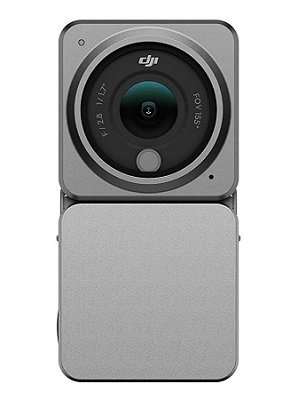
DJI Action 2
The Osmo Action 2 is a sophisticated action-cam in a very compact size. But unlike the Insta360, the Action 2 doesn’t just focus on size, but also on high picture quality as well as a wide range of functionalities.
And while the manufacturers of Insta360 already had a modular action-cam in their lineup with the One R, but that camera always included at least two additional components. The Action 2, on the other hand, works without any additional attachments.
It is housed in a cube-shaped hard case with a 1.76-inch touchscreen on the back and a centrally placed control button at the top. The small screen is crisp thanks to a pixel density of 350 PPI that is sufficiently bright even in broad day light. And despite the small size, its touch operation is surprisingly good.
Meanwhile, the technology behind the Action 2 remains as good as the competitors’: It records videos in 4K with a generous 4096×3072 pixels and up to 120fps (“frames per second”). For an even smoother experience, you can switch to 2.7K or HD and then even film at 240fps.
Furthermore, the maximum recording bitrate is a decent 100 Mbps, which is good for action-packed recordings. Plus, the entire rear panel is equipped with a 1.7-inch OLED display.
All in all, if you are looking for a small, lightweight and unobtrusive action cam for your motorcycle helmet, DJI’s Action 2 is the right choice. Its modular design is ingenious; it is equipped with the right accessories to suit every type of motorcycle riders. And if desired, it can be turned into a selfie cam with magnetic modules that have a second screen.
In terms of video quality, the Action 2 does keep up with the GoPro 10; 4K recordings look sharp and natural at the same time and the reliable image stabilization compensates for frequent shakes and bumps.
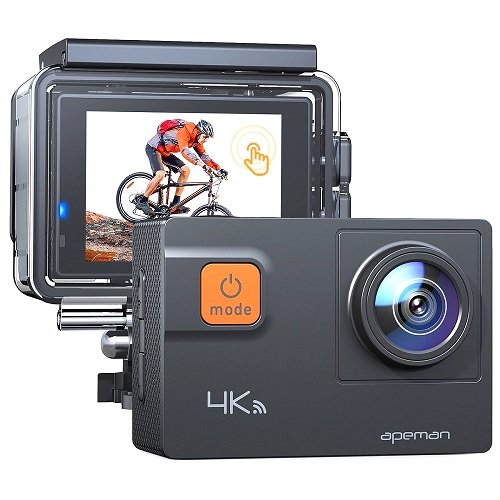
Apeman A87
The Apeman A87 action camera is the last on the list, but this does not mean that it is the last in quality among motorcycle helmets cameras. It has all the impressive features that can be found in any high-end action camera, and you will have an access to all the tools that come equipped on an expensive option, yet you pay only a tenth of their price. In other words, this is another insanely affordable option for motorcyclists who are looking for a cheap but good quality action camera.
The model has been upgraded to record up to 4K HD resolution at 60fps. You will be able to record in several modes, including continuous loop, single frame, slow motion, and several other video modes depending on different environmental conditions. Thanks to the ultra-responsive touchscreen display on the side, you can quickly switch between different settings such as preview, footage playback and shooting.
It comes equipped with a carrying case and 22 different accessories, including two extra rechargeable batteries. Considering its price tag, the Apeman A87 is a great choice, especially if you’re just starting out as a beginner.
Things to consider while choosing a helmet camera
Majority of the renowned brands have worked tirelessly to improve the reliability and functionality of their action cameras. So, whether you are into extreme or adventure motorcycle sports, action camera allows you to capture the moments with minimalistic difficulties. Lately, the market is filled with wide range of models that are equipped with wide variety of technical and operational characteristics. However, users should consider the following important aspects when choosing a motorcycle helmet camera.
- Ease of use; no matter how sleek, beautiful, lightweight, durable, and functional a camera is, it’s useless if you can’t use it. The last thing you want to do is fiddle with the device while riding. This is both risky and illegal, and it’s just not worth it. Try to choose models with single button or the ones that have voice control; the freer you are from the camera, the pleasant and safe your ride will be.
- Frames per second; choosing the right motorcycle sport camera should depend on several factors. First of all, pay attention to the image resolution that this camera offers. The best are 4K devices. Recording at 60fps or 30fps allows for smooth images even at higher speeds. Image stabilization is extremely important in motorcycle cameras. Thus, the frames are practically motionless even if you are driving on uneven surfaces. Usually, special suspensions are used for stabilization. In this case, there is no such need.
- Lens angle; the angle of the lens is very important. Narrow lenses (110 degrees) allow most of the terrain around the motorcycle to pass. Cameras with a wide angle lens (140-160 degrees) will be a much better choice, capturing not only what is happening in front of the motorcycle, but also the scenes on the sides.
- Resolution; modern day helmet cameras have a resolution of at least 1080 pixels. Take higher if possible, but don’t settle for less. While footage captured with a lower resolution camera may look decent on a small device like a smartphone, you definitely won’t enjoy viewing it on a wide screen TV, laptop, or computer. While 4K is usually too much, but you can choose 4K when you really need crystal clear images. One thing is certain; with 4K, you can be absolutely confident while displaying pictures even on the largest TV screens.
- Size; this is a no brainer, bulky or heavy cameras are not suitable for helmets. You don’t need anything to affect your posture or balance when riding a powerful vehicle like a motorcycle. Besides, a bulky camera takes away the fun of riding. It is best to choose lightweight, small or portable cameras. If you can feel the weight of the camera after attaching it to your helmet, then you should probably ditch it.
- Mounting options; a device with limited mounting options may not be the right fit for your needs. Consider options that provide the ability to mount on helmets, handlebars or other locations where you prefer to fix for a unique angle.
- Battery life; look for models that provide a battery backup of at least 90 minutes. It’s even better if you purchase models that have a backup of 120 minutes. After all, it’s the last thing that you would want to worry about during an adventure. Some models come with extra batteries, for instance, Campark ACT74. The set includes not one, but two additional batteries.
- Video capture settings; do you desperately need to shoot in 4K? Or is 1080p enough? What is your video editing skill level? Looking for image stabilization? These are some of the important questions to be answered before choosing the right action camera for your motorcycle helmet. Your answers will help save you money without having to spend it on unnecessary features.
- Touch screen; the built-in touchscreen is another useful feature that assists recording while riding. Touch screens allow you to quickly access and change settings or switch between modes. You can also preview your footage on screen before transferring it to your computer or other devices. Also note that some small cameras do not have a screen on the side or at the back. So, while portability is a great feature, you’ll have to find a balance between small size and the ability to easily change settings.
- Durability; choose a helmet camera with a durable body. Rugged, waterproof camera is suitable for recording in all weather conditions and on all bike tours. No matter how amazing the features are, you’re more likely to start looking for a new one if it turns out to be short-lived. Fortunately, all the cameras on this list are reliable and carefully selected. In addition, they are suitable for most of the motorcyclists.
- Storage options; if you want to record long duration videos, your best bet are cameras that record to an SD card. One of the worst things that can happen while recording is running out of memory. This bitter experience alone can darken your entire motorcycle trip, at least for a while. To prevent inconvenience, avoid cameras with features that only offer built-in storage.
- Transferability; many modern day action cameras have the ability to share beautiful photos and videos wirelessly. While wireless sharing is not a mandatory requirement, it makes things a lot easier while transferring files from one device to another.
- Sound; Sound quality only matters if you are using the action camera for specific purposes other than recording while riding a motorcycle. Wind noise at high speeds will drown out any engine sounds or your voice. So don’t get hung up on the quality of the sound, instead, focus on features that deliver high quality photos and recordings. However, if you need to record clear sounds, purchase a dedicated microphone for this purpose.
Bottom line
To fully enjoy the action camera, you need to choose between the models of well-known brands and manufacturers. Lately, there are many “incomprehensible” action cameras of unknown brands (mostly Chinese) available in the market, which are positioned by sellers as “100% replacement for GoPro action cameras, but 2 times cheaper”. You need to understand that “2 times cheaper” makes the quality of the components two times worse. Besides, these cameras rarely work appropriately for more than 2-3 months, after which a person is forced to either completely abandon an action camera or opt for a branded one.
We also have a detailed guide on best action cameras for dirt biking. So, in case you are an off-road enthusiast, do take a look!

